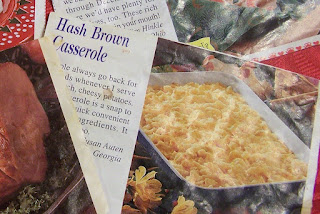Of these recipes that I return to every Christmas I’ve tweaked some to reflect my family’s palate preferences. For instance, I use a different cut of ham and stud it with cloves before slathering on the glaze. I puree the canned potato soup before adding it to the hash brown casserole, and I’ve fiddled a little with the rest of the ingredients. For the cheesecake, I use a chocolate graham cracker crust from which I leave out the sugar, and I use about 2 cups of cranberries but don’t change any other ingredients, for I’ve found we need the extra tartness to offset the cloying sweetness of eggnog. No matter, though. These recipes taste like home to us.
Here’s the Cranberry Cheesecake recipe.
Sugar-Glazed Ham
adapted from Taste of Home magazine
(This size ham will easily feed 15 people, or you can eat it all yourselves, with plenty left over for frying for breakfast the next morning, and the next, and the one after that, which is what we like to do.)
a handful of whole cloves
¾ cup white wine or water
2 cups packed brown sugar
4 teaspoons prepared mustard
2 to 4 tablespoons cider vinegar
Preheat your oven to 325˚. Score the ham in a diamond pattern about ½ inch deep with a sharp knife. Insert a whole clove into each scored intersection. Place the ham on a rack in a shallow baking pan. Pour the wine into the pan. Insert a meat thermometer into the center of the ham, without touching the bone. Bake for 2 to 2 ½ hours, or until the thermometer registers 150˚.
Meanwhile, combine in a small bowl the sugar, mustard and enough cider vinegar to make a thick paste.
When the ham reaches 150˚, remove it from the oven and raise the temperature to 350˚ (so that you can finish baking the ham and bake the hash browns at the same time). Use a paring knife to remove the rind and excess fat. Slather the glaze over the ham and baste it with some of the drippings. Return it to the oven. Bake another hour, or until the thermometer registers 160˚. Let it rest about ten minutes before slicing; spoon over the pan drippings and serve.
Hash Brown Casserole
adapted from Taste of Home magazine
(We apparently have big appetites for despite its recommended 12 to 15 servings, we have found that this amount will comfortably feed eight people.)
1 (10 ¾-ounce) can condensed cream of potato soup
1 ½ cups sour cream
½ teaspoon garlic salt
1 (1-pound, 14-ounce) package frozen hash brown potatoes
2 cups (8 ounces) shredded cheddar cheese
½ cup grated Parmesan cheese
Preheat your oven to 350˚. Grease a 13- by 9-inch baking dish.
Puree the soup until smooth. Pour it into a bowl and mix it well with the sour cream and garlic salt. Add the potatoes and cheddar cheese and stir to combine. Spoon everything into your greased baking dish and sprinkle the Parmesan cheese on top. Bake, uncovered, for about an hour, or until the potatoes are tender and the top is all yummy and crisp.
A very merry Christmas to you and yours. I’ll see you on the other side.














